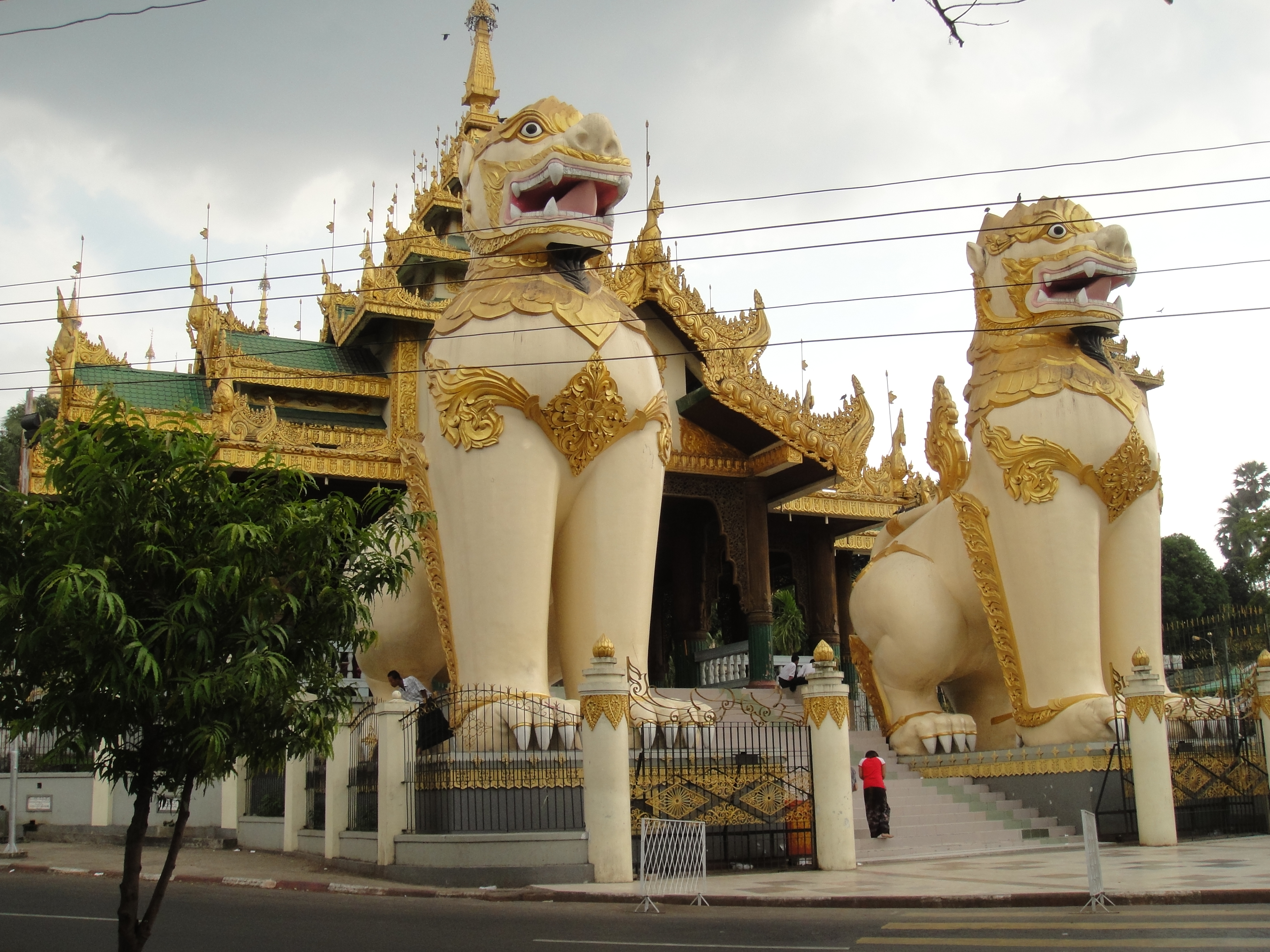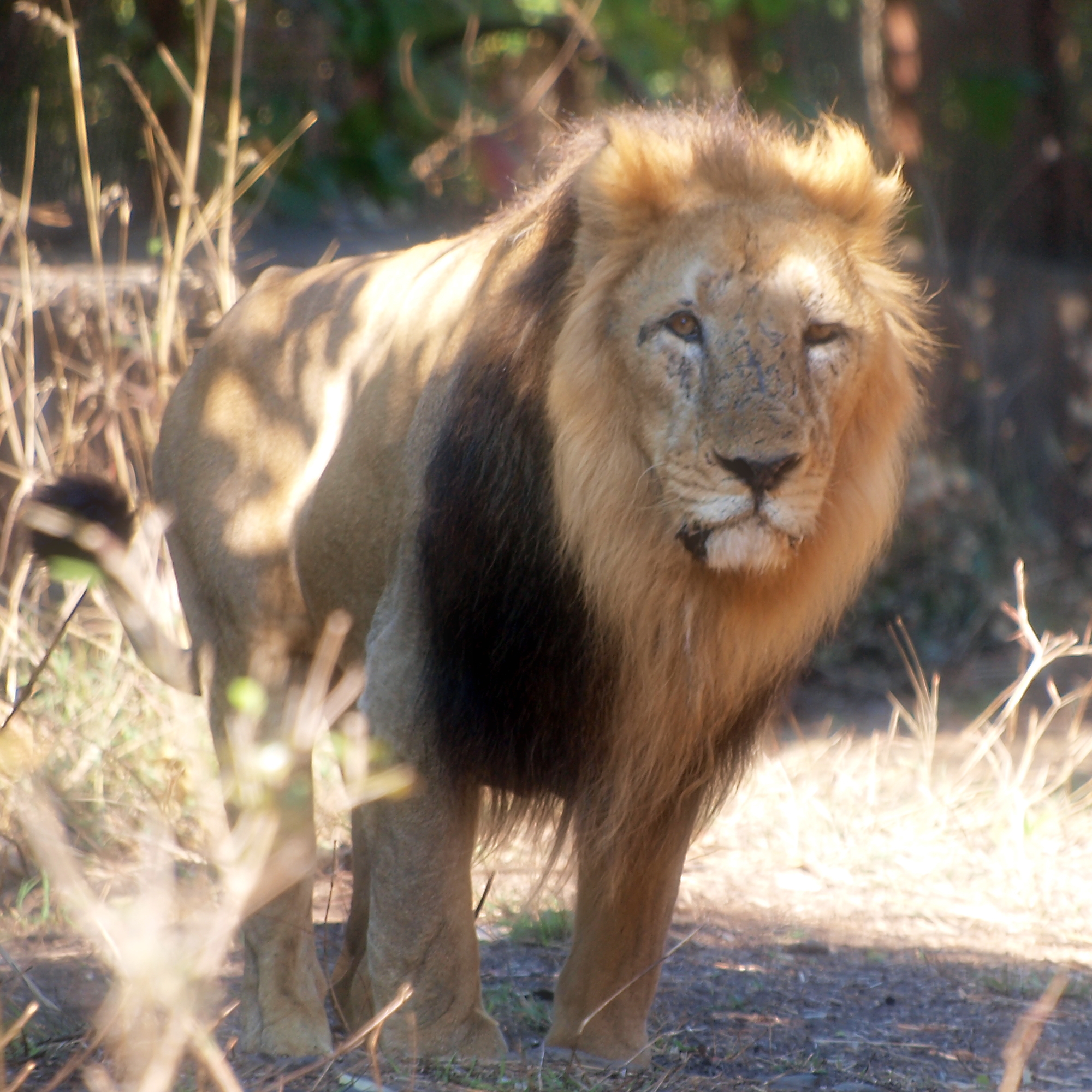Chinthe on:
[Wikipedia]
[Google]
[Amazon]

 ''Chinthe'' ( my, ခြင်္သေ့ (); mnw, ဇာဒိသိုၚ် (); shn, သၢင်ႇသီႈ ()) is the Burmese word for '
''Chinthe'' ( my, ခြင်္သေ့ (); mnw, ဇာဒိသိုၚ် (); shn, သၢင်ႇသီႈ ()) is the Burmese word for '
 In contrast to popular foreign beliefs, the ''Chinthe'' is not a mythical creature but instead an entirely natural lion, although often associated with Buddho-Burmese myths.
The Burmese leograph is related to other stylized lions in the Asian region, including the ''sing'' (สิงห์) of
In contrast to popular foreign beliefs, the ''Chinthe'' is not a mythical creature but instead an entirely natural lion, although often associated with Buddho-Burmese myths.
The Burmese leograph is related to other stylized lions in the Asian region, including the ''sing'' (สิงห์) of
File:Bagan-Ananda-220-Chinthes-gje.jpg, Leographic statues line the rooftop at Bagan's Ananda Temple
File:Bagan 2019 10.jpg, Close-up of the stylized lion head, Ananda Temple
File:Bagan Bronze Bell (7566104478).jpg, Temple bell in Bagan, Myanmar
File:Bagan-Dhammayazika-20-Loewe-Ministupa-gje.jpg, Lion statue on Dhammayazika Pagoda, Bagan, Myanmar
File:Chinthes guarding Mandalay Hill.JPG, A pair of whitewashed lions guard the entrance to

lion
The lion (''Panthera leo'') is a large cat of the genus '' Panthera'' native to Africa and India. It has a muscular, broad-chested body; short, rounded head; round ears; and a hairy tuft at the end of its tail. It is sexually dimorphic; adu ...
'. The leograph of ''Chinthe'' is a highly stylized lion
The lion (''Panthera leo'') is a large cat of the genus '' Panthera'' native to Africa and India. It has a muscular, broad-chested body; short, rounded head; round ears; and a hairy tuft at the end of its tail. It is sexually dimorphic; adu ...
commonly depicted in Burmese iconography and architecture
Architecture is the art and technique of designing and building, as distinguished from the skills associated with construction. It is both the process and the product of sketching, conceiving, planning, designing, and constructing buildings ...
, especially as a pair of guardians flanking the entrances of Buddhist pagoda
A pagoda is an Asian tiered tower with multiple eaves common to Nepal, India, China, Japan, Korea, Myanmar, Vietnam, and other parts of Asia. Most pagodas were built to have a religious function, most often Buddhist but sometimes Taoist, ...
s and ''kyaung
A ''kyaung'' (, ) is a monastery ( vihara), comprising the domestic quarters and workplaces of Buddhist monks. Burmese ''kyaungs'' are sometimes also occupied by novice monks (samanera), lay attendants ('' kappiya''), nuns ('' thilashin''), and y ...
'' (or Buddhist monasteries).
Natural lion
 In contrast to popular foreign beliefs, the ''Chinthe'' is not a mythical creature but instead an entirely natural lion, although often associated with Buddho-Burmese myths.
The Burmese leograph is related to other stylized lions in the Asian region, including the ''sing'' (สิงห์) of
In contrast to popular foreign beliefs, the ''Chinthe'' is not a mythical creature but instead an entirely natural lion, although often associated with Buddho-Burmese myths.
The Burmese leograph is related to other stylized lions in the Asian region, including the ''sing'' (สิงห์) of Thailand
Thailand ( ), historically known as Siam () and officially the Kingdom of Thailand, is a country in Southeast Asia, located at the centre of the Indochinese Peninsula, spanning , with a population of almost 70 million. The country is b ...
, Cambodia
Cambodia (; also Kampuchea ; km, កម្ពុជា, UNGEGN: ), officially the Kingdom of Cambodia, is a country located in the southern portion of the Indochinese Peninsula in Southeast Asia, spanning an area of , bordered by Thailand ...
, Laos
Laos (, ''Lāo'' )), officially the Lao People's Democratic Republic ( Lao: ສາທາລະນະລັດ ປະຊາທິປະໄຕ ປະຊາຊົນລາວ, French: République démocratique populaire lao), is a socialist s ...
, and the ''simha'' (සිංහ) of Sri Lanka
Sri Lanka (, ; si, ශ්රී ලංකා, Śrī Laṅkā, translit-std=ISO (); ta, இலங்கை, Ilaṅkai, translit-std=ISO ()), formerly known as Ceylon and officially the Democratic Socialist Republic of Sri Lanka, is an ...
, where it is featured prominently on the Sri Lankan rupee
The Sri Lankan Rupee ( si, රුපියල්, ta, ரூபாய்; symbol: Re and Rs (plural) in English, රු in Sinhala, ௹ in Tamil; ISO code: LKR) is the currency of Sri Lanka. It is subdivided into 100 cents, but cents are rar ...
. It is also related to East Asian leographs, such as the guardian lions of China, ''komainu
, often called lion-dogs in English, are statue pairs of lion-like creatures either guarding the entrance or the ''honden'', or inner shrine of many Japanese Shinto shrines or kept inside the inner shrine itself, where they are not visible to the ...
'' of Japan, ''shisa
is a traditional Ryukyuan cultural artifact and decoration derived from Chinese guardian lions, often seen in similar pairs, resembling a cross between a lion and a dog, from Okinawan mythology. Shisa are wards, believed to protect from some ...
'' of Okinawa and Snow Lion of Tibet.
Origins
The story of why the lions guard the entrances of pagodas and temples is given in the '' Mahavamsa'':The princess Suppadevi ofVanga Kingdom Vanga was an ancient kingdom and geopolitical division within the Ganges delta in the Indian subcontinent. The kingdom is one of the namesakes of the Bengal region. It was located in southern Bengal, with the core region including present-day ...(present dayBengal Bengal ( ; bn, বাংলা/বঙ্গ, translit=Bānglā/Bôngô, ) is a geopolitical, cultural and historical region in South Asia, specifically in the eastern part of the Indian subcontinent at the apex of the Bay of Bengal, predom ...) had a son namedSinhabahu Sinhabahu (Sinha = Lion, Bahu = Arm) is a legendary king of ancient India, mentioned in Sri Lankan texts. He was father of Vijaya of Sri Lanka and king of Sinhapura. He was the son of Supadevi, a Vanga Kingdom Vanga was an ancient kin ...through her marriage to alion The lion (''Panthera leo'') is a large cat of the genus '' Panthera'' native to Africa and India. It has a muscular, broad-chested body; short, rounded head; round ears; and a hairy tuft at the end of its tail. It is sexually dimorphic; adu ..., but later abandoned the lion who then became enraged and set out on a road of terror throughout the lands. The son then went out to slay this terrorizing lion. The son came back home to his mother stating he slew the lion, and then found out that he killed his own father. The son later constructed a statue of the lion as a guardian of a temple to atone for his sin.
In Burmese culture
The leograph of ''Chinthe'' appears as an element of Burmese iconography on many revered objects, including the ''palin'' (Burmese royal throne) and Burmese bells. Predating the use of coins for money, brass weights cast in the shape of iconic animals like the ''Chinthe'' were commonly used to measure standard quantities of staple items. In theBurmese zodiac
The Burmese zodiac ( my, ဇာတာ ရာသီခွင် ) is the traditional Burmese system of astronomy and astrology. While it is still an important component of the Burmese calendar, today, the zodiac is closely identified with Burmese ...
, the lion sign is representative of Tuesday-born individuals.
The leograph is featured prominently on the successive post-independence State seals (including the current State Seal of Myanmar
The State Seal of the Republic of the Union of Myanmar ( my, ပြည်ထောင်စုသမ္မတမြန်မာနိုင်ငံတော် နိုင်ငံတော်အထိမ်းအမှတ်တံဆိပ ...
) and most paper denominations of the Burmese kyat, and its statues are found as guardian statues of most pagodas and temples.
Gallery
Mandalay Hill
Mandalay Hill ( ) is a hill that is located to the northeast of the city centre of Mandalay in Myanmar. The city took its name from the hill. Mandalay Hill is known for its abundance of pagodas and monasteries, and has been a major pilgrimage ...
File:So Hla Waing 2.jpg, Chinthe of So Hla Waing in Bagan, Myanmar
File:Suspension of the Mingun Bell.jpg, Chinthe atop the Mingun Bell
Relation to Second World War Chindits
During theSecond World War
World War II or the Second World War, often abbreviated as WWII or WW2, was a world war that lasted from 1939 to 1945. It involved the vast majority of the world's countries—including all of the great powers—forming two opposi ...
, the British Brigadier Orde Wingate
Major General Orde Charles Wingate, (26 February 1903 – 24 March 1944) was a senior British Army officer known for his creation of the Chindit deep-penetration missions in Japanese-held territory during the Burma Campaign of the Second Worl ...
was given command of forces charged with long-range penetration
A long-range penetration patrol, group, or force is a special operations unit capable of operating long distances behind enemy lines far away from direct contact with friendly forces as opposed to a Long Range Reconnaissance Patrol, a small group ...
operations behind Japanese lines in Burma
Myanmar, ; UK pronunciations: US pronunciations incl. . Note: Wikipedia's IPA conventions require indicating /r/ even in British English although only some British English speakers pronounce r at the end of syllables. As John C. Wells, Joh ...
. At the suggestion of Captain Aung Thin of the Burma Rifles The Burma Rifles were a British colonial regiment raised in Burma. Founded in 1917 as a regiment of the British Indian Army, the regiment re-used the name of an unrelated earlier unit, the 10th Regiment (1st Burma Rifles) Madras Infantry, which evol ...
, Wingate decided to call this force "The Chinthes" (The Lions),Duckworth, L.B (1945). Your Men in Battle: The Story of the South Staffordshire Regiment- 1939-45. Michigan, USA: Express and Star. p. 17. a name which became corrupted to "The Chindits
The Chindits, officially as Long Range Penetration Groups, were special operations units of the British and Indian armies which saw action in 1943–1944 during the Burma Campaign of World War II.
The British Army Brigadier Orde Wingate form ...
" and was so recorded in the annals of World War II.
See also
*Asiatic lion
The Asiatic lion is a population of '' Panthera leo leo'' that today survives in the wild only in India. Since the turn of the 20th century, its range has been restricted to Gir National Park and the surrounding areas in the Indian state of Gujar ...
*Chinese guardian lions
Chinese guardian lions, or imperial guardian lions, are a traditional Chinese architectural ornament, but the origins lie deep in much older Indian Buddhist traditions. Typically made of stone, they are also known as stone lions or shishi () ...
*Shisa
is a traditional Ryukyuan cultural artifact and decoration derived from Chinese guardian lions, often seen in similar pairs, resembling a cross between a lion and a dog, from Okinawan mythology. Shisa are wards, believed to protect from some ...
* Shishi
*Singh
Singh (IPA: ) is a title, middle name or surname that means " lion" in various South Asian and Southeast Asian communities. Traditionally used by the Hindu Kshatriya community, it eventually became a common surname adopted by different comm ...
*Lion dance F
Lion dance () is a form of traditional dance in Chinese culture and other Asian countries in which performers mimic a lion's movements in a lion costume to bring good luck and fortune. The lion dance is usually performed during the Chinese New Y ...
Notes
References